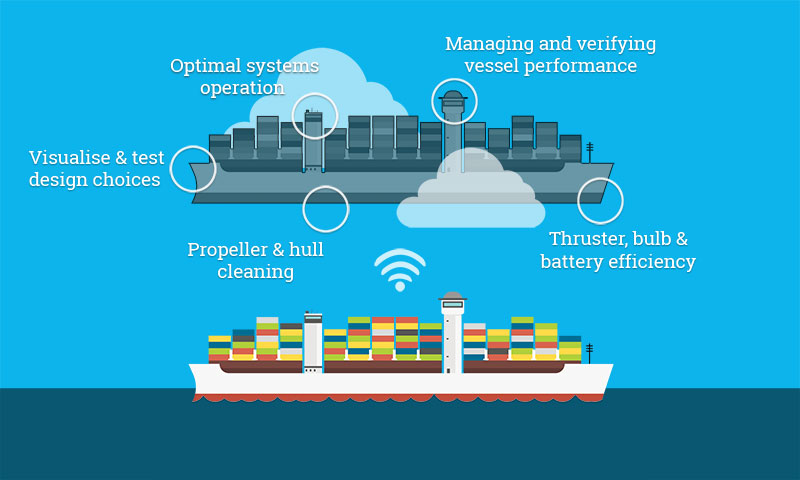数字化已成为海运业的一个重要组成部分,其最终目的是使海运业更具创新性和效率。
数据与数字化齐头并进,随着海运业测试和采用新的数字技术,有关航运的可用数据的数量和质量成倍增加。有潜力通过日益复杂的分析和可视化工具优化运营的数据。
数字双船是一个概念,通过连续的数据收集,实现对船舶、其流程、系统和潜在场景的数字表示。传感器、通信通道、连接和控制系统等技术的发展都实现了航运业的数字孪生。
这些技术的不断改进使生产、运营、预测性维护和许多其他潜在应用的模型得以建立,从而使设计得以改进,新特性的测试以及性能、安全性和完整性的评估得以实现。也许这些应用程序中最令人兴奋和雄心勃勃的是自动化。
数字孪生兄弟与自动化
The uptake of digital’s role within the shipping industry has been slow. Some may say this is due to the shipping industry’s struggle with technology acceptance and technology adoption (yes, there is a difference), but the more measured response to this is that innovation takes time.
It is never a singular moment or event, and is the product of vision, experimentation and the drive to succeed.
技术是创新的驱动力和使能器。随着它渗透到航运业中较小的角色或应用,它的价值已经实现。毫无疑问,从这些应用程序中收集的数据模型正在实现数字孪生模型,并且已经并且将提供从发动机性能改进到增强船体完整性的所有信息。从处女航的第一天起,到船舶退役之日,都可以进行分析。这些数据将是帮助海运业发展、提高效率和环境友好的关键。

从理论上讲,有各种各样的操作可以受益于数字孪生,这些已经发展到包括系统设计、有效的保证和验证服务、基于模拟器的测试、培训和虚拟系统集成,以及产生深刻的见解和预测。
The operations and insights from the digital twin are leading the first steps towards autonomy - the creation of efficient algorithms for remote controlled, and self-controlled, components and operations. A digital twin vessel fuelled with an integrated data loop is fundamental to the augmentation and advancement of autonomy.
目前,自主航运仅限于开发和测试在国家水域进行专门作业的自主船舶。
2018年末,我们看到法尔科,第一艘完全自主的(汽车)渡轮。“猎鹰”号在芬兰帕莱宁和瑙沃的终点站之间穿梭。在旅途中,“猎鹰”号综合运用了劳斯莱斯的船舶智能技术,能够避开一艘静止的船只,在目的地无人协助下停泊。在返回航段,渡轮由Finferries在图尔库的操作中心远程控制。
In 2019, we will see the testing of theYARA Birkeland,第一个全电动和自治的集装箱r ship, with zero emissions. Initially, the vessel will have a small crew and the ship will sail two routes in Norway - between Herøya and Brevik, and between Herøya and Larvik. As sensor, automated, manual and predictive data is gathered and analysed from these scenarios and simulations, this enhances pattern detection, uncovering anomalies and improving decision-making.
记录到“数字孪生”号上的数据将为他们的数字生态系统增加有价值的层面,并使船只走向自主运行。
计划到2022年,该船将实现完全自主。就亚拉-伯克兰号而言,实现航运自治,有一些优点需要提及。
这艘船是由YARA支付、拥有和经营的,只用于运输他们的产品,船很小,从不离开挪威领海,只访问3个港口。
Falco也有类似的优点,可以进行测试和操作。仅凭这些因素,这些船舶就避免了对国际航运行为守则、规章和适用的许多关切。
Penetration, adoption & standards
为了使自治在整个航运业产生重大影响,它需要渗透(意识和考虑)、采用(船上)和一套普遍标准。
在航运业中采用自主船舶和技术一样,将受到环境的严重影响。
各国、监管机构、组织和公司在采用新技术和自动化方面都处于同一水平。很容易理解的是,在成为主流之前,自主船只的采用将首先在一些地区或部门逐步进行。
We will need to see the development of a Code of Practice for design, construction and operation of autonomous maritime systems. With that, regulators and the law will need to keep up with technology.
How will autonomous ships comply with current seaworthiness obligations, safe manning levels, the duties of the shipmaster, and compulsory pilotage?
Consider that compulsory pilotage laws literally vary from port to port, meaning that autonomous ships may not be permitted to berth in some ports. Thus, their usefulness as cargo-carrying vessels will be limited unless these issues are resolved at an international level.
While not every shipowner, builder or operator is at this stage of technology adoption, we must also bear in mind that running a port or ship building involve hefty capital investments, and one can understand why stakeholders need to see proof of concepts before signing on the dotted line.
雅拉·伯克兰号的造价大约是同尺寸常规船的三倍——甚至不考虑实现这一现代奇迹所需的研发成本。
虽然从长远来看可以节省运营成本,但制造这些船舶的成本增加无疑会使其投保成本增加。船舶在航行中会遇到各种各样的情况。任何情况的后果可能包括:碰撞、搁浅、沉没、货物损失或(最坏情况下)生命损失。
在紧急情况下的安全性、性能和操作性随着时间的推移得到证实之前,我不会想象这些保险成本会下降。随着我们在数字化(尤其是自主化)方面迈出这些步伐,我们的目标是提高效率,减少或消除人为错误。然而,我们不能忽视的是,这种对技术的依赖可能会为其他问题让路,而这些问题的后果可能会更加昂贵。
数字错误可能造成人身伤害,或使港口和船只受到网络罪犯的攻击。
可靠和安全的通信渠道将在构建数字孪生系统的成功过程中变得越来越重要,远程操作和自动化将需要持续的数据连接。
这项工作将是昂贵的,但技术的不断改进和传播意味着数字技术正在变得比以往任何时候都更便宜,并可供更多的人和行业使用。
我们准备好放手了吗?
自主性的一个定义是一个人(在这种情况下是计算机)做出自己决定的能力。
我想一个好问题是需要多少数据才能实现自治?多少数据足够?
在这里,缓慢过渡到自主的对话变得非常明智。以最简单的形式,我们将信息处理分为四个阶段:信息获取、分析、行动选择和执行。
The above-mentioned factors aside, to achieve safe and efficient autonomy will require a large volume of sensor, automated, manual and predictive data. The scope for the digital twin to allow for processing of large volumes of information, scenarios and potential outcomes is unprecedented but the human factor is not going away anytime either.
Instead, the appearance of remote-controlled, autonomous or even unmanned vessels will transform the role of the seafarer. The World Maritime University noted in a recent report that, “Despite high levels of automation, qualified human resources with the right skill sets will still be needed in the foreseeable future.”
我们可能看到的是海员的进化,在我们看到完全自动化之前,我们可能更可能看到由人类操作员监督的船只。
海员的技能和任务将向数字化方向发展。这些船只仍然需要有能力和有创意的工程师团队的支持,他们比实际操作工作更擅长操作监控和系统管理,这将产生令人兴奋的新角色和机会。
Keep your finger on the pulse of the trends, technologies, processes and projects transforming shipping through digitalisation. Book your seat forShipping2030在丹麦的哥本哈根。



























